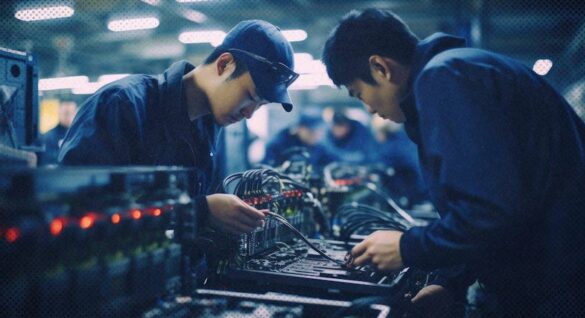
The People’s Republic of China and Technology
We are in a Second Cold War with China, even though few Americans recognize that fact.
Recently, Niall Ferguson referred to the period we are now in as the Second Cold War. This noted and recently knighted historian recognizes what most Americans do not — that we are at war with China. It’s a cold war, but a war nonetheless.
Most are blissfully unaware. Folks are busy living their lives, attending school, working, raising kids, pursuing dreams, or, if retired, visiting grandkids and enjoying life. Most are ignorant of the malign designs of the Chinese Communist Party (CCP) of the People’s Republic of China (PRC). China expert Gordon Chang warns that China is an extreme danger to Americans.
Dr. Michael Pillsbury of The Heritage Foundation predicts China will overtake America as the world’s superpower. Former Trump National Security Advisor Lt. Gen. H.R. McMaster of the Hoover Institution has sounded alarms about the PRC in congressional testimony. Unfortunately, too little heed is paid to these warnings. Americans don’t want a world ruled by China, but most are completely oblivious to the strong possibility that such is in our near future.
In a startling analysis by the Australian Strategic Policy Institute (ASPI), China’s leadership in most technology fields is documented in detail. Decades ago, the Chinese embarked on a plan to catch up to the U.S. in various fields of technology critical to national success both economically and militarily. Based on the data in ASPI’s report, they have largely done that. Technology is crucial to national wealth, influence, and strength. According to ASPI, China is a leader in most fields, and in the fields in which it is not the leader, it is second. In many instances, China is not just the leader but the leader by a huge margin. For an example of the detail of these assessments of world leadership in technology, visit ASPI’s Technology Tracker.
According to ASPI, the PRC is the world’s leader or near-peer in multiple disciplines, including important fields such as:
- Artificial Intelligence technology
- Advanced Information and Communications Technology
- Advanced Materials and Manufacturing
- Biotech; Gene Therapy and Vaccines
- Energy and Environment
- Quantum
- Sensing, Timing and Navigation
- Transportation
- Robotics
- Space
For a snapshot of all technology assessed, visit the ASPI Critical Technology Tracker.
What does this information mean? Why should we care about such esoteric matters? We should care because the world thrives on innovation and advancement, and the leader in technology will have a competitive advantage over others both militarily and economically.
The undersecretary of defense for research and engineering said in a policy statement in February 2022, “Strategic competitors to the United States have greater access to commercial state-of-the art technologies than ever before and can wield these technologies to be disruptive to America’s interests and its national security. The challenges facing our country are both diverse and complex, ranging from sophisticated cyber-attacks to supply chain risks, and from defending against hypersonic missiles to responding to biological threats. In an ever shifting and fast-moving global environment, technological advantage is not stagnant, and the Department cannot rely on today’s technology to ensure military technological dominance tomorrow.”
The undersecretary went on to identify key areas of emphasis where the U.S. must maintain leadership to allow the U.S. to defend itself from potential enemies, namely the PRC. A partial list of these emphases are:
- Biotechnology
- Quantum Science such as atomic clocks, quantum sensors, quantum computing, and quantum networks
- Quantum computing and quantum sensors
- Wireless network technologies
- Advanced materials technology
- Artificial Intelligence
- Integrated Network Systems-of-Systems technology
- Microelectronics
- Space technologies
- Renewable energy generation and storage
- Advanced computing and software technologies include supercomputing, cloud computing, data storage, computing architectures, and data processing
- Human-Machine Interface
- Directed Energy Weapons such as lasers, high-power microwaves, and high-energy particle beams to produce precision disruption, damage, or destruction of military targets at range
- Hypersonic systems at or above five times the speed of sound, or approximately 3,700 miles per hour
- Integrated Sensing and Cyber capabilities
ASPI’s data confirms China leads the U.S. in many of the technology areas that DOD leaders have identified as critical. The fact that the PRC leads or is a peer to the U.S. in most of these areas should cause grave concern. Our success in battle is no longer assured because the high technology that we have relied on in the past is now a strength of our adversary, the PRC.
The president’s budget for 2025 proposes $143 billion for R&D, or 16.8% of the defense budget. Is that what it will take to be able to beat the PRC in a war that is right around the corner? The defense budget is 3% of GDP, the lowest percentage since the end of WWII. The president’s total budget proposal for FY2025 is $7.3 trillion. Defense R&D, which we urgently need to defend ourselves from the PRC and other enemies, is a paltry 1.9% of the budget. Can the U.S. continue to underinvest in defense in favor of huge sums going to social programs, welfare, funding for support of illegal immigrants, debt relief for college students, subsidies for technology related to climate change, billions in more foreign aid to Ukraine, and liberal causes overseas? Inquiring minds want to know.
Source: https://patriotpost.us/articles/107877-the-peoples-republic-of-china-and-technology-2024-06-24